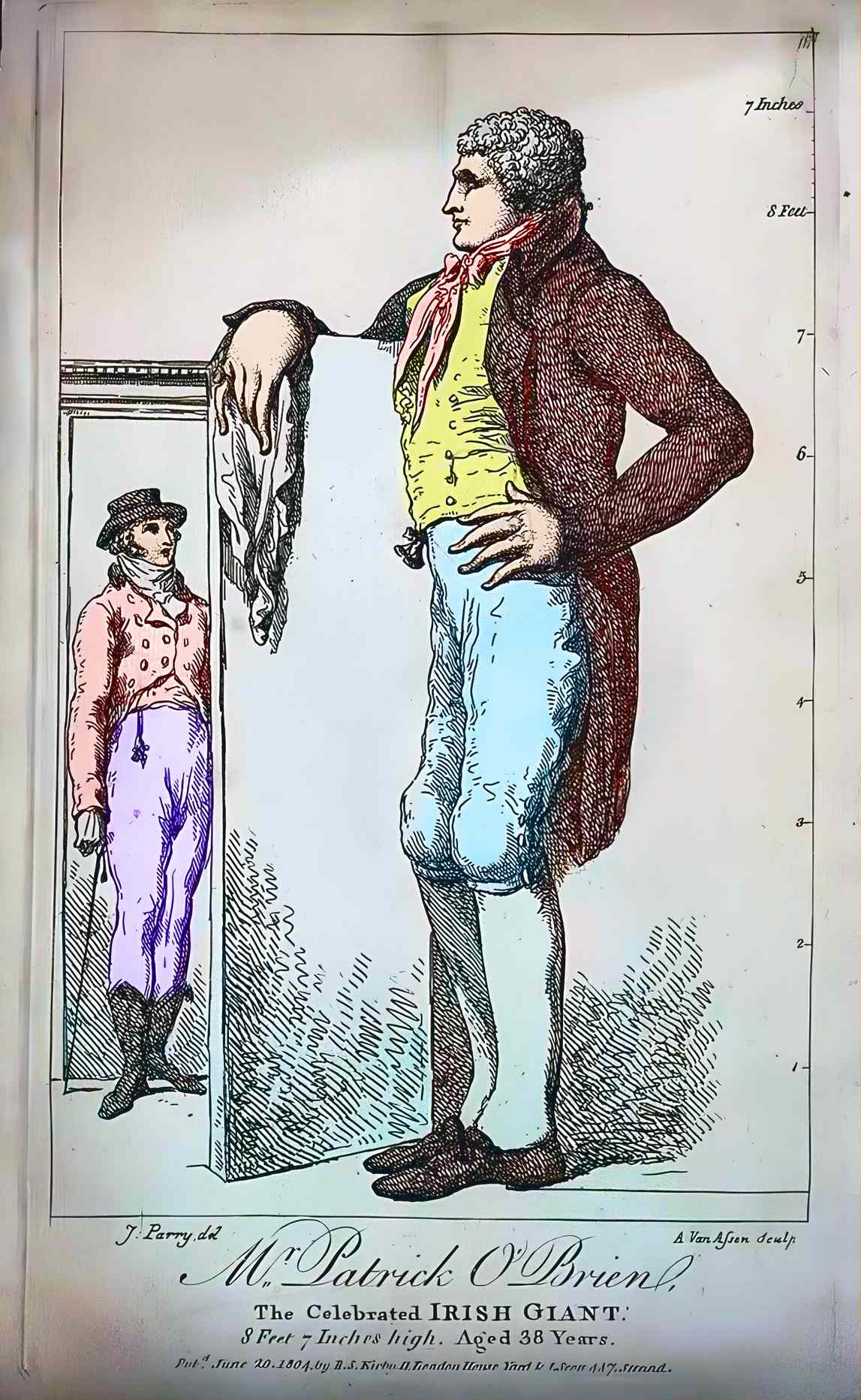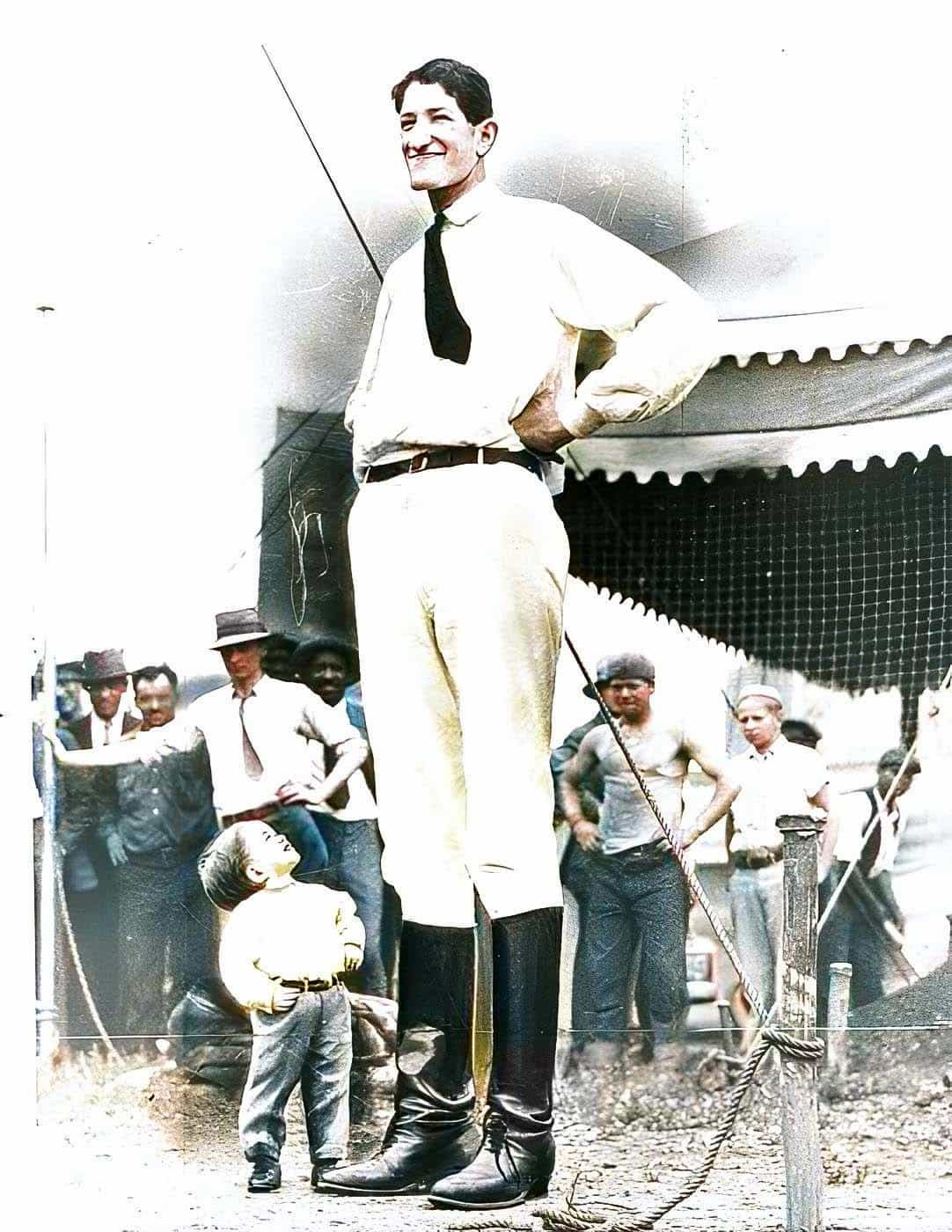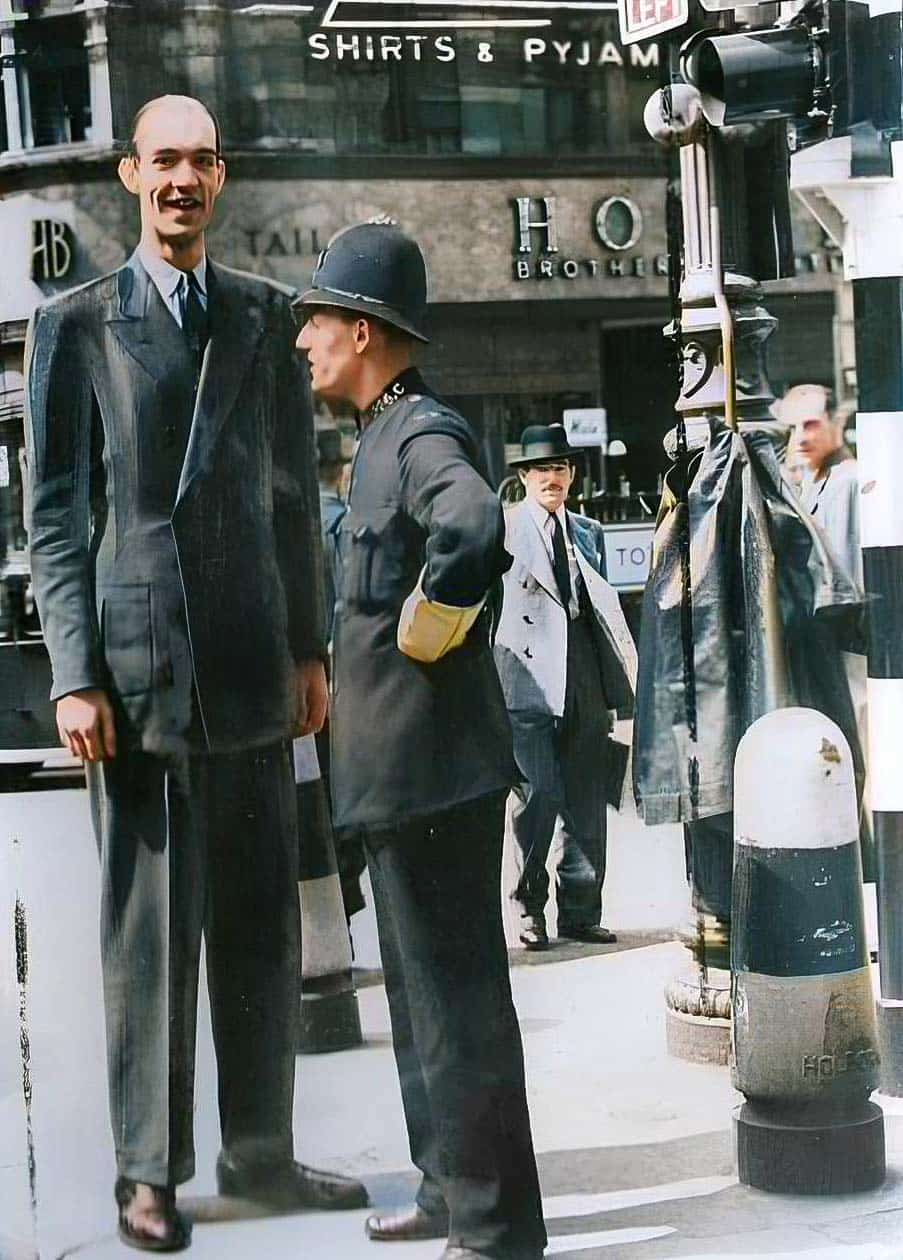When a man with gigantism named Patrick Cotter was exhibited in London at the end of the 18th century, he had given himself the surname “O’Brien” after a legendary Irish king. Patrick Cotter O’Brien (Kinsale, January 19, 1760–September 8, 1806) was one of the only 20 people in history whose heights were verified to be at least 8 feet long.
The Demise of Patrick Cotter O’Brien
Patrick Cotter traveled to London in April 1782 to exhibit himself to Charles Byrne, because he was said to be 8 feet 2.4 inches tall (2.50 m). But later exhumations of his bones would reveal his true height to be 8 feet (2.44 m). One London newspaper said on May 6, 1782:
“Although it is easy to attract curiosity, it usually costs more to capture the attention of the public; but this is not the case with the modern-living Colossus, the wonderful Irish giant. As soon as he arrived at an elegant apartment in Spring Garden, door to door with the Cox Museum, curious people of all kinds flocked to see him, knowing that such a prodigy had never before appeared among us (…)”.
That day, Patrick Cotter adopted the surname, O’Brien, pretending to be a descendant of the legendary king of Ireland with giant stature. During a night out, someone took Patrick’s riches after he foolishly traded them for a bank guarantee. As his mood deteriorated, O’Brien turned to heavy drinking. His body was discovered in his residence in June of 1783. His age was given as 22.
O’Brien’s dying request was to be tossed into the ocean, despite the fact that he knew every doctor in London would kill for his bones. The doctors and surgeons he assumed would be standing watch outside his house shortly after his death confirmed his worst predictions. One publication said that when the death certificate was released, the doctors were ready to pay for the services of divers to retrieve his remains.
John Hunter and O’Brien’s Body
John Hunter was a pioneer in the field of experimental pathology and is considered a great anatomist of all time. In 1763, he purchased property on which he would later construct a house and a zoo filled with both tamed and wild animals. In 1783, when he was already wealthy, well-known, and well-regarded, he purchased a home in Leicester Square and turned it into the Hunterian Museum and Art Gallery.
It was a shrine to the natural world and its inhabitants. His collection of stuffed whales was unparalleled, and he also had access to exotic creatures like opossums and kangaroos. The concept of “monsters” became more than just a novelty to him; it became an integral component of his worldview. The museum has the biggest collection of congenital abnormalities in the world.
Patrick Cotter O’Brien was, without a doubt, a prized possession of his. It was reported that Hunter’s undismayed determination to exhibit O’Brien drove him to drink. Hunter made this Irish giant feel like he was not more than a kangaroo or a whale, a unique specimen destined to be exhibited in a showcase.
O’Brien devoted his final few kilos to the battle with Hunter because he was determined to come out on top against people like him. The individuals O’Brien recruited deceived the physicians and made their way to the shore with the massive casket. It’s important to remember that English doctors in the 1700s didn’t think twice about stealing dead bodies.
It was a profitable and horrific industry because physicians didn’t hesitate to pay the worst types of individuals to steal corpses. The legal supply was restricted to the hung bodies, but the executions weren’t enough to meet the requirements of the growing number of medical schools.
Since the job paid handsomely, roving bands of thieves filled London’s mass graves at night. This kind of thing was only stopped decades later because of the Burke and Hare murders scandal, which in turn inspired Robert Louis Stevenson to end this nonsense.
Hunter, who was no stranger to such illegality, found out about Patrick Cotter O’Brien’s death via his criminal contacts and paid a sizable fee to attend his burial. On a second-to-last night, O’Brien’s companions took a break at an inn and placed the coffin in a barn. Following them were Hunter’s men, who invited O’Brien’s companions to drink some whiskey until they were drunk enough. At this point, they moved the body to their wagon while filling the coffin with stones.
The following day, the coffin was tossed into the Irish Channel while no one noticed anything was wrong. John Hunter put the body in a big caldron so he could save the skeleton. The caldron and skeleton are still on display at the museum. Studies conducted on him at the turn of the twentieth century revealed not only his true height but also the cause of his gigantism: a tumor in the pituitary gland, similar to the case with Robert Wadlow, John Middleton, or other giants like John Rogan and Bernard Coyne.
Who Was Patrick Cotter O’Brien?
Patrick Cotter, who was born in Kinsale (County Cork, Ireland) in 1760, was discovered while working as a bricklayer and given £50 a year for three years by a businessman who planned to exhibit him in Bristol. Nonetheless, Cotter later expected a share of this business after seeing its spectacular success.
One time, Cotter was leased out to a colleague without his knowledge or consent, which enraged Cotter so much that the businessman falsely accused him of owing money and threw him in jail.
William Watts, a businessman from Bristol, felt sorry for Cotter, arranged to have him released from prison, and assisted him in staging his own performance. Cotter made a tidy £30 over the course of three days at the St. James’s Fair.
To commemorate his giant Irish predecessor, he renamed himself Patrick O’Brien and moved into a London apartment, where he performed for two shillings from eleven to four in the morning and evening for the wealthy and the poor (for one shilling), respectively.
It was said that at the Sadler’s Wells theater, he would surprise the young ladies who came on the second floor with a kiss and would come down from the stage to meet the rest of the audience. O’Brian allegedly stalked the streets at night, smoking his pipe from the flames of lamppost lights, since he frightened youngsters by day.
Being a tailor for O’Brian was problematic. Jokingly, O’Brian once wrote to Watts about the commission of socks in three weeks: “and that is three years ago, so I don’t know what to think…” Cotter is seen in an engraving from 1803 with one elbow propped on top of an open door while a tailor sits on a chair nearby to take his measurements.
When Cotter got back to Bristol, he had a massive carriage pulled by several horses made for himself. Once, a police officer saw this massive car and pulled it over. The officer was so terrified when Patrick opened the door that he ran away. When he arrived at his destination in another London-hired cart, the coachman said to his coworkers:
“I have worked more than all of you put together, for I have carried a monument.”
The coachman to his coworkers, who rode Patrick Cotter O’Brian in a horse cart.
His Height
On September 8, 1806, Patrick Cotter O’Brian died from a liver illness. He expressed a desire to be laid to rest at the Catholic church on Trenchard Street, but he was concerned that his corpse might be stolen and used as a scientific experiment by a surgeon, as later happened to him.
O’Brian had a 140-inch-deep (3.5 m) rock-cut tomb built for him and lined it with masonry and iron bars. None of his fourteen undertakers were allowed to drink alcohol while on the job.
Despite widespread speculation that his efforts had been fruitless, his enormous coffin was discovered to be unbroken in 1906. Cotter’s height was allegedly inscribed as 8 feet 4 inches (2.54 m), but this was discovered to be fiction, and the actual measurement of his height was 8 feet (2.44 m). The length of his skeleton was 7 feet and 9.7 inches (2.38 m).
If a malformation of the spine was ignored, the pathologists calculated that Patrick Cotter O’Brien would have been 8 feet tall (244 cm) in life. His eyewear, a walking cane, a shoe, and a massive 5 feet 1 inch (155 cm) mahogany chair are all on display in the Bristol City Museum.
However, the 1.1-pound gold watch (500g) that Cotter presented to his benefactor Watts in thanks for getting him out of jail is missing. His chippendale chair was also on display at The Lion Bar in Bristol until it was purchased by a German in 1977, and it is now nowhere to be found.
In 1972, his skeleton was reexamined, and a publication detailing the findings revealed that he had stood at a height of 8 feet 1 inch (2.46 m). In 1986, his body was dug up again for a short funeral before being cremated due to construction plans in the region.






